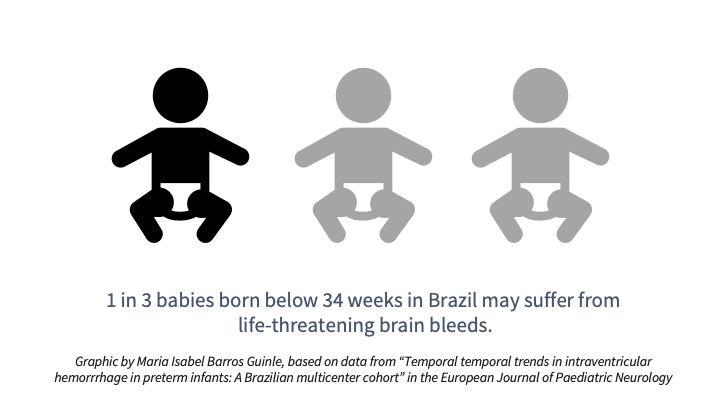Published: 01/10/2024
How an International Collaboration Aims to Reduce Deadly Brain Bleeds in Brazilian Babies
By Maria Isabel Barros Guinle, Stanford Medical Student
As many as 1 in 3 babies born below 34 weeks in Brazil may suffer from life-threatening brain bleeds. But, hopefully, not for much longer. Collaborative efforts by Stanford physician-scientists and Brazilian neonatologists promise to give us new clues to which babies are at risk and how we can treat them.
Dr. Gabriel Variane, a Brazilian neonatologist with Protecting Brains and Saving Futures (PBSF) has been on a mission to reduce the number of premature infants who suffer life-altering brain damage ever since he was struck by the magnitude of the problem as a doctor in a Brazilian hospital’s neonatal intensive care unit. After connecting with Stanford physician-scientist, Dr. Valerie Chock, almost 10 years ago, they have now united forces again to solve a problem that plagues Brazilian nurseries.

In a given year, more than 5 million babies around the world may develop life-threatening brain bleeds called intraventricular hemorrhages (IVH). Its toll weighs particularly heavy in Brazil, where studies on risk factors are limited and strategies that have reduced the incidence of devastating brain hemorrhages in some high-income countries have still not been successfully adopted.
This new international collaboration led by Chock, Variane, and Brazilian neonatologist Dr. Rafaela Pietrobom, a medical director of PBSF, seeks to rewrite this narrative for millions of children. In an initiative supported by a Stanford Global Health Seed Grant co-funded by Stanford’s Maternal & Child Health Research Institute, they are partnering with five hospitals across Brazil to identify risk factors unique to Brazilian premature infants and, eventually, to reduce the rate of this debilitating condition across the country.
A dangerous condition that evades solutions in Brazil
Intraventricular hemorrhages are a dangerous complication for newborns worldwide in which the highly fragile blood vessels of the infant rupture and bleed into the fluid-filled areas in the brain. For reasons that are not yet well understood, those born prematurely in middle-income countries like Brazil are particularly at risk. One of the few known risk factors for intracranial hemorrhages is prematurity, due to the infants’ particularly fragile, developing blood vessels. Brazil has a high rate of prematurity, with approximately 1 in 10 babies being born early. This means that, every year, hundreds of thousands of Brazilian babies go on to develop life-altering, and potentially lethal conditions.
Valerie Chock, MD, Division of Neonatal and Developmental Medicine at Stanford“We must be cognizant of the environment, the resources, and the culture unique to a particular population so that we can really individualize care for our babies.”
Apart from preterm birth, other risk factors for these brain bleeds remain poorly understood. While some solutions have helped prevent intraventricular hemorrhage in countries like Canada and the U.S., implementing them in Brazil, where healthcare disparities make patient outcomes highly variable, is particularly challenging. Brazil has one of the largest universal healthcare systems in the world. But the quality of care in federally funded centers varies greatly depending on location, staffing, and resource allocation. In addition to government-run centers, Brazil also has several private hospitals, which add to the heterogeneity of care one can receive when they enter a maternity ward.
Understanding how to provide neonatal care equitably in this unique healthcare landscape can be challenging.
Chock, a professor of pediatrics in the Division of Neonatal and Developmental Medicine at Stanford Medicine, recalls being struck by this discrepancy during one of her visits.
“You can be in a very well-resourced, private hospital and walk two blocks down to a government-funded hospital and see that those families may not have access to the same type of care,” she recounts.
Pietrobom agrees that these disparities pose a significant barrier to achieving standardization of care across the hospitals they are partnering with. Because the centers involved in their study include both private and government-run institutions, their team seeks to develop strategies that work equally well across very different settings.
A promising solution
Chock, who is an epidemiologist in addition to a physician, is excited about the data they have been able to collect from their partner institutions thus far. She said she hopes the information will help them better characterize risk factors unique to Brazil. Long-term, Chock, Variane, and Pietrobom plan to use their understanding of these risk factors to help identify the most promising interventions that have a real shot at succeeding in the Brazilian population. They also hope to raise awareness of brain injury among Brazilian colleagues and encourage more researchers to be part of the solution.
An example of the team’s successful collaboration was in a previous project educating Brazilian healthcare providers about brain injury due to low oxygen levels at birth. One of the therapies that has shown promising results in other countries is therapeutic hypothermia. This is exactly as it sounds: Doctors cool babies down for 72 hours and slowly rewarm them. Doing so helps to improve survival and preserve neurological function. However, it comes with some risks. The procedure can slow babies’ heart rates to low levels and sometimes lead to seizures when rewarming them. Well-trained medical professionals in hospitals with the appropriate technologies can reduce these risks by monitoring closely and intervening with other treatments when needed.
The team is investigating ways to support hospitals with vastly different resources in successfully implementing this highly standardized technique. They strive to ensure that this approach is successful given Brazil’s heterogeneous medical landscape. The team said that a primary goal is using education to ensure that the changes can be continued long beyond this project.
In the last few months, for example, they have strategized ways to use live closed caption translation services so that U.S. doctors can help communicate with and train Brazilian health professionals providing this treatment. They are also developing online boot camps that can help teach medical staff how to use their neuromonitoring tools and induce therapeutic hypothermia properly. These efforts, they hope, will expand their local capacity to safely treat more babies for years to come.
Key Takeaways
Chock says that this partnership has not only shed light on a critical healthcare issue that demands global attention, but it also highlights the urgent need for culturally sensitive, sustainable approaches in global health. “We must be cognizant of the environment, the resources, and the culture unique to a particular population so that we can really individualize care for our babies,” she stated.
The researchers hope that their approach to advancing local medical knowledge, their commitment to providing equitable care, and the scientific discoveries they will make in the coming year will help Brazil reach a day when no baby suffers from this deadly threat.

